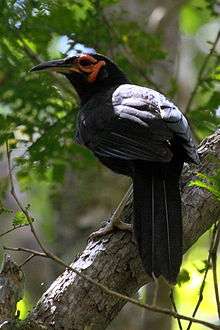Crow honeyeater
The crow honeyeater (Gymnomyza aubryana) is a very large honeyeater endemic to humid forests in New Caledonia in the South Pacific.[2]
| Crow honeyeater | |
|---|---|
 | |
| Scientific classification | |
| Kingdom: | Animalia |
| Phylum: | Chordata |
| Class: | Aves |
| Order: | Passeriformes |
| Family: | Meliphagidae |
| Genus: | Gymnomyza |
| Species: | G. aubryana |
| Binomial name | |
| Gymnomyza aubryana Verreaux & Des Murs, 1860 | |
The species measures 35 to 42.5 cm (13.8–16.7 in).[2] It has orange facial wattles. It superficially resembles a crow with its glossy black plumage and a curved beak. Crow honeyeaters have long rounded wings and a long tail and neck. Their bill is long and bicolored – yellow below, black above. It has a loud, ringing call, which is predominantly heard in the early mornings.
It is relatively inconspicuous, and lives either in pairs or alone. It forages for invertebrates and nectar in the canopy and midstory.
This bird is critically endangered due to introduced rats. Extensive surveys have only found it in the Parc de la Rivière Bleue area, on the slopes of the Kouakoué, in the Pourina and Ouiné valleys, at Rivière Blanche and on the slopes of Mont Pouédihi and Mt Panie. It is spread throughout the island, though mostly in the south. It is estimated that there are between 50 and 249 birds left.
References
- BirdLife International (2013). "Gymnomyza aubryana". IUCN Red List of Threatened Species. 2013. Retrieved 26 November 2013.CS1 maint: ref=harv (link)
- Higgins, P., Christidis, L., Ford, H. & Sharpe, C.J. (2017). Crow Honeyeater (Gymnomyza aubryana). In: del Hoyo, J., Elliott, A., Sargatal, J., Christie, D.A. & de Juana, E. (eds.). Handbook of the Birds of the World Alive. Lynx Edicions, Barcelona. (retrieved from http://www.hbw.com/node/60405 on 12 June 2017).
